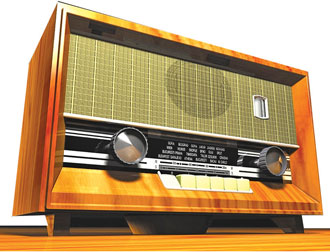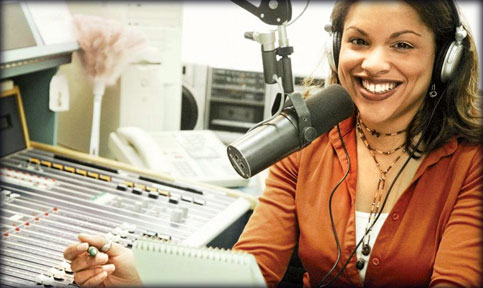Coming soon - the age of ‘My Radio’
by Lional Wijesiri
It was a dull rainy Saturday in the late 1940s. I was a young boy
living with my parents. To break the monotony of the day, my father
said, “Let’s make a crystal radio set.” He had the items needed for the
job, which included (as I remember) some enamel coated magnet wire, a
Germanium diode, an old telephone handset, a set of alligator jumpers
and stranded insulated wire for an antenna. For three hours, he guided
me to complete the DIY job and finally my first crystal radio came into
existence. From that day onwards, my love for radio sets and its
technology never waned but grew up with my age.
 I have witnessed how the world began to change and the improved radio
receiver becoming a standard household fixture in most homes. I saw how
subsequent research gave rise to countless technical improvements and
how they changed radio programming drastically. I have witnessed how the world began to change and the improved radio
receiver becoming a standard household fixture in most homes. I saw how
subsequent research gave rise to countless technical improvements and
how they changed radio programming drastically.
With the advent of TV, I saw how the migration of the most popular
programs from radio to television took place. Radio programming became
mostly music and news and, to a lesser extent, talk shows.
Today radio is no more the King. Movies, TV, internet and mobile
content are competing for our attention. Fewer are listening to
broadcast stations. Online radio stations abound and podcasts seem to be
here to stay. When virtually anyone can create content and make it
available to the world, what is the long term prognosis for terrestrial
radio stations? Will they have a place in the future or will they be
essentially superfluous?
A little bit of a history lesson on broadcast radio, does prove the
misconception of previous threats as being the final nail in Radio’s
coffin. With the birth of television, many predicted radio's demise –but
it never happened. Then came tape recorders, eight-track tapes, and CDs,
yet radio still survived.
However, many of those new choices did tap into the huge audiences
that radio enjoyed in its heyday, but no nail was found. When FM radio
began turning the tide of listeners from AM, once again many predicted
the death of AM radio. But it didn’t happen. So, even though the
audience is shrinking, radio still remains an important and reliable
medium.
One of the recent challenges to take on the radio broadcast business
in most countries is satellite radio. Satellite radio did begin to take
a bite out of broadcast radio as the new technical gadgets became a must
for audio savvy users.
Radio revolution
However, in the shadows of the satellite radio revolution, broadcast
radio was preparing to comeback on an even digital platform, with the
arrival of HD Radio.
In HD Radio, (where Sri Lanka is yet to experience), your favourite
local station remains in the same place on the radio dial, but when you
have a new digital HD Radio receiver, your AM sounds like FM and FM
sounds like CDs. In addition, the wireless data feature enables text
information – titles, artistes, local weather or local traffic alerts –
to be broadcast directly to your receivers display screen. HD Radio even
gives consumers access to other media platforms, such as iTunes tagging,
where you can download an on-air song to your iPod.
 As we move forward into the technologies of the 21st century, we must
not overlook the Wi-Fi revolution, which has quietly spread across the
globe providing wireless internet, mobile, and broadcasting to a whole
new level. New Wi-Fi units are now providing thousands of online radio
stations, which include broadcast and internet-only channels. In the new
landscape, you can listen to your local radio station on-air, via
internet and mobile phone devices. As we move forward into the technologies of the 21st century, we must
not overlook the Wi-Fi revolution, which has quietly spread across the
globe providing wireless internet, mobile, and broadcasting to a whole
new level. New Wi-Fi units are now providing thousands of online radio
stations, which include broadcast and internet-only channels. In the new
landscape, you can listen to your local radio station on-air, via
internet and mobile phone devices.
Challenges
The challenges for radio broadcasters in the 21st century is huge.
Broadcasters are looking for new perspectives to make the business
profitable and face digital media competition.
Radio research has reached a two way perspective, with researchers
understanding radio both as sound broadcasting and other forms of media,
as well as questioning radio as a social institution.
Radio has advantages over the other mass media like television and
newspapers in terms of being handy, portable, easily accessible and
cheap. It is the most easily portable of the broadcast media, being
accessible at home, in the paddy field or the farm, in the office, in
the car, on the street or beach, virtually everywhere at any time.
Radio is effective not only in informing the people but also in
creating awareness regarding many social issues and need for social
reformation, developing interest and initiating action. For example, in
creating awareness regarding new policies, developmental projects and
programs, new ideas etc.
It can help in creating a positive climate for growth and
development. Radio is a fine medium for education when it is followed up
with group discussion and question- answer session. Moreover, radio
serves small highly targeted audiences, which makes it an excellent
advertising medium for many kinds of specialised products and services.
Mobility
As far as audience is concerned radio does not hamper person’s
mobility. As a vehicle of information for masses it is still the
fastest. For instance, it would take less time for a news reporter for
radio to arrive on the spot with a microphone and recorder than the same
for TV along with a shooting team and equipment.
Another important feature of radio as mass medium is that it caters
to a large rural population which has no access to TV and where there is
no power supply. In such places, Radio's programs continue to be the
only source of information and entertainment.
We don't know exactly what radio will look like in 20 years (or if
we'll even still call it that), but its safe bet that it would it be
utterly unrecognisable by the likes today’s FM Radios.
We'll always have audio, but transmission via radio waves will be
augmented by wireless Internet standards like 4G mobile broadband and
Wi-Fi.
Those networks will carry much more interactive and smarter audio
content, which will likely push traditional broadcasters toward a more
personalised experience.
By the next decade, radio will be the world’s social audio network,
inviting the audience to share and create content.
Stations in USA already launch free apps that listeners use to
record, edit, and submit audio, video and picture to the station, which
it may use on-air and online.
Mobile apps involve people in your radio station 24/7 – especially
when you have a young audience you can create a mobile social community
to interact and crowd source.
Choice
The audience will have more choice than ever, as a huge amount of
stations will emerge through the unlimited capacity of IP-based
channels. It’s an opportunity to serve exactly defined audience
demographics through personalised niche radio stations. The age of ‘My
Radio’ is here.
Production and distribution techniques will also change, but radio
will still be a friend that keeps you company.
Engaging radio personalities will tell interesting stories and offer
a mixture of information and entertainment. Radio will continue to have
the unique selling proposition and this X-factor of emotion will be the
heart of radio that people will always love. |

